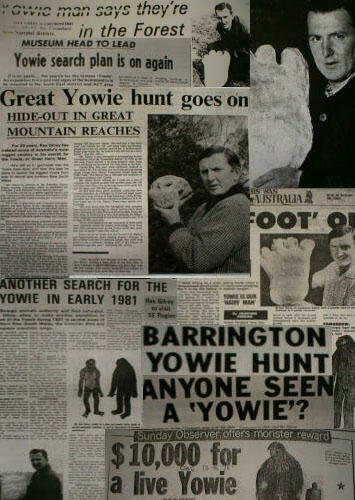The Yowie - Myth or Mystery |
N.Z. mystery man-Apes |
The Yowie Man |
On the track of Myths |
Australia The Cradle Of Civilisation
Post Special Report
by Rex Gilroy
Australasian Post, December 24, 1986
Australia The Cradle Of Man
According to our "traditional" history of stone-age occupation the Aboriginals were the "first Australians" having arrived here from south-east Asia at least 50,000 years ago. However, throughout a lifetimes research, I have gathered more than enough evidence that we still know nothing about our ancient past and the identity of the actual first inhabitants of our continent. Until 1960, very little archaeological work had been done. Scientists thought the Aboriginals had only lived in Australia for 10,000 years.
Then finds at Kenniff Cave, in southern Queensland, produced evidence of Aboriginal occupation dating from as recently as 5,000 years ago back to 19,000 years. This placed the Aboriginal arrival into the last ice-age. In recent years archaeologists have made some amazing discoveries on the Blue Mountains west of Sydney. Rock shelter occupation sites at Leura, Blackheath and Wentworth Falls have revealed artifacts 12,000, 14,700 and 22,000 years old respectively, while recently near the eastern escarpment of the Blue Mountains on the Nepean River further excavations gave evidence of occupation dating back 45,000 years.
Hairy man roams Mountains |
The Yowie |
Hermits unlock hairy man Mystery |
Hunt for elusive Yowie |
Hairy man shocks Mark Foy |
Hairy man evades Hunters |
Hairy man of the Blue Mountains |
The Yowie Exists |
Yowie sighted in Dubbo |
Yowie man wants army to Search |
The Yowie - myth or Mystery |
Woronora wild man - Hoax! |
The great white yowle Hunter |
Ow! Look out for the Yowie! |
Yowie..! It's the missing Link |
Giant hairy beast - monster or Myth |
Yowie pads' spur on stalking Party |
Observor offers monster Reward |
Newspaper articles 60's-70's-80's-90's-2000+
Australia The Cradle Of Civilisation
This site along with another found recently at Warrambool {v}, 80,000 years old, is one of the oldest known Aboriginal sites in Australia. In 1967, at Kow Swamp, in northern Victoria, archaeologists found ancient burial sites between 15,000 to 9,000 years old.
The skeletal remains unearthed display marked anatomical differences to those of modern Aboriginals. The ancient Kow Swamp people were much more robust and heavily built, their skulls much thicker, larger and longer, with large, wide and very projecting facial structure quite different from those of modern Aboriginal.
They had huge cheek bones and big eyebrow ridges, receding foreheads, huge teeth and jaws. Further significant fossil man discoveries were made soon after at Lake Mungo in south-western New South Wales.
A female skeleton excavated here and carbon dated to be 25,000 years old, displayed delicate modern features, more akin to those of modern humans. At the time the skeleton was considered to be the oldest evidence of a modern human in the world. Then a few years later, 100 km away at Lake Nitchie, further fossil remains were found on the ancient shoreline.
The skeleton of a male of 187 cm height, and very similar to the Kow Swamp remains, was excavated from a burial site, as recent as 6500 years old. These discoveries demonstrate that two distinct races of people inhabited Australia at the same time, during the last ice-age. Scientists now tend to believe that these two races inter-bred to produce the modern Aboriginal.
Some anthropologists now believe the robust {Kow Swamp} race to be decendants of the Java Man {home erectus} of 500,000 years ago, while the smaller Lake Mungo race came to Australia from China, probably decendants of the Peking Man {Homo pekinensis} and later Java type, Wadjak Man.
Sea levels during the last ice-age were much lower that they are today, at least 100-130 metres. Tasmania was joined to the Australian mainland-as was New Guinea. At the time, stone-age people could have almost walked from Asia into Australia, but because of areas by up to 100 km of open sea in places, making crossing by boat necessary. This would make these people the earliest seafarers in the world.
The first inhabitants of our land shared it with some fantastic creatures, for instance the giant monitor lizard {megalania presca}, which grew up to 10 metres in length; Kangaroos up to 4 metres tall; the Diprotodon, a giant Wombat-like marsupial twice the size of a rhinoceros; and an Emu about 7 metres tall. They also had to adapt to Australia's harsh environment, forcing them to develop better tools and weapons; during which they also developed the oldest stone-age art in the world.
